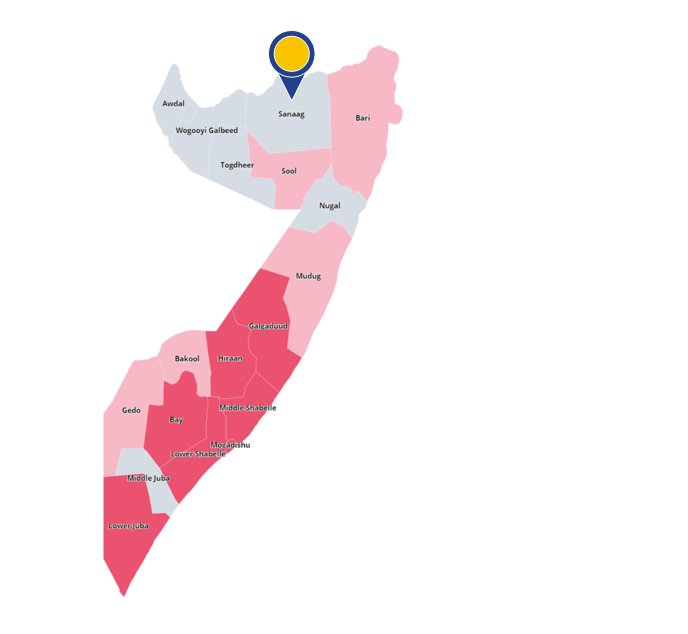COMMON ANALYSIS
Last update: August 2023
The situation in Sanaag should be seen in light of the situation in the neighbouring regions, among others, Sool and Bari.
Main COI references: [Security 2023, 2.7.2., pp. 172-178; COI Update 2023, 1.1.1., p. 7; 1.3.4., pp. 16-19]

General information
Sanaag region consists of three districts. The region’s capital is Ceerigaabo.
The population of Sanaag is divided into Warsangeli (Harti) and Isaaq clan groups. Eastern Sanaag is primarily inhabited by Warsangeli, part of the Harti confederation together with the Majerteen clans of Puntland. The western part of Sanaag, including the capital Ceerigaabo is mainly inhabited by Habar Yunis, an Isaaq sub-clan. Dhulbahante (Harti) are also present in parts of southern Sanaag.
In 2021, UNOCHA estimated the population of Sanaag at 362 721 inhabitants.
Background and actors involved in armed confrontations
Puntland and Somaliland dispute over political and military control of areas of the Sool and Sanaag regions as well as the area of Ayn, part of Togdheer region. Sool and Sanaag fall within Somaliland’s boundaries, as per the old Anglo-Italian border and protocol and as put forward by the Somaliland government.
Somaliland forces are in control of the western part of Sanaag, including Ceel Afweyn town and the capital Ceerigaabo. The area bordering Bari region, including Dhahar town, is claimed both by the Somaliland administration and Puntland’s autonomous forces. Puntland controls Sanaag’s eastern part, including Badhan and Laasqoray towns and the Milho village.
Old tensions oppose the Dhulbahante clan and Somaliland over long-standing self-determination demands of the clan which declared, in early January 2023, Sool and Sanaag regions as parts of the Federal Republic of Somalia and asked the Somaliland forces to withdraw from the area.
In June 2022, after discussions in the context of a conference held in the region’s capital, Warsangeli clans and the government of Somaliland agreed that the ‘Warsangali community is fully part of the Somaliland Republic.’
Al-Shabaab is present in the northeastern part of the region, around the Golis Mountain range. The group is involved in gold mining activities and is imposing taxation to the local population despite the presence of Puntland and international counter-terrorism forces.
Nature of violence and examples of incidents
The number of security incidents in the reference period was relatively low (9 incidents).
Al-Shabaab was one of the main actors of violence in the region. The group was involved in 4 out of 9 incidents, mainly in battles against Puntland security forces. All four incidents occurred in Milho village. For example, in March 2022, the group launched an artillery attack against a Puntland military base in Milho village. According to a Puntland official, the attack was repealed by Puntland’s autonomous forces.
Inter and intra-clan disputes, involving clan militias, over grazing land, water resources, mining rights and political power occurred. Inter clan disputes occurred, for example, between Warsangeli and Isaaq clans around the capital Ceerigaabo about mining rights. Intra-Warsangeli disputes over land issues also took place. These tribal rivalries didn’t evolve into large conflicts.
A suicide attack in a grocery store in Milho village on 11 September 2022, that resulted in the death of at least 5 people and the injury of 11 people has also bee reported. In another instance, in January 2022, clan militias took control of Ood-La village in Damala Xagare area and destroyed buildings and water reservoirs.
Incidents: data
ACLED recorded 9 security incidents (an average of 0.1 security incidents per week) in Sanaag region between 1 July 2021 and 30 November 2022. Out of those incidents, 4 were coded as ‘battles’, one as ‘remote violence / explosions’ and 4 as ‘violence against civilians’. In the period from 1 December 2022 to 14 April 2023, 5 security incidents were recorded in Sanaag representing an average of 0.3 security incidents per week.
Geographical scope
Security incidents occurred in all districts of Sanaag region with the largest overall number being recorded in Ceerigaabo district (5 incidents).
Fatalities among civilians and non-civilians
In the 17 months between July 2021 and November 2022, ACLED recorded a total of 14 fatalities in the region. In the 4.5 months between December 2022 and mid-April 2023, ACLED recorded a total of 5 fatalities in the region. Compared to the figures for the population in the region as from 2021, this represents approximately 5 fatalities per 100 000 inhabitants for the whole reference period.
Displacement
The key reason for displacement in Sanaag was the insecurity linked to Al-Shabaab activity or clan-based disputes.
Between July 2021 and November 2022, 571 individuals were newly displaced from Sanaag
according to PRMN. Of those, 77 % were displaced within the region, while the remaining 133 individuals were displaced to Wogoyi Galbeed and Bari. In the same period, 206 individuals arrived in Sanaag from Bari region as a result of conflict and insecurity.
Between December 2022 and March 2023, 12 individuals were newly displaced from Sanaag, according to PRMN.
Further impact on civilians
Two humanitarian access incidents were documented by UNOCHA during the reference period. Both incidents occurred in Ceerigaabo district.
Looking at the indicators, it can be concluded that in the region of Sanaag, there is, in general, no real risk for a civilian to be personally affected within the meaning of Article 15(c) QD.
